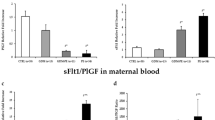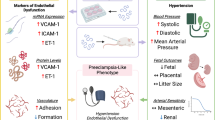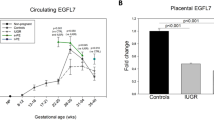Abstract
Placental overproduction of anti-angiogenic soluble fms-like tyrosine kinase-1 (sFlt-1) and soluble endoglin (sEng) has a key role in the development of preeclampsia (PE). Circulating endothelin-1 (ET-1) levels are also elevated in PE. In this study, we investigated the correlation between ET-1 and sFlt-1, placental growth factor (PlGF), sEng levels during uncomplicated normotensive pregnancy and PE. A total of 218 pregnant primigravid women were enrolled: 110 with PE and 108 uncomplicated normotensive pregnancies. PE was defined as new onset of elevated blood pressure (BP) >140/90 mm Hg and ⩾2+ proteinuria on two occasions after 20 weeks of gestation in previously normotensive pregnant women. Circulating ET-1, sFlt-1, sEng and PlGF levels were estimated using enzyme immunoassays, and correlation between variables was ascertained. Women with PE showed higher levels of sFlt-1 (41.5±15.7 vs 6.15±3.4 ng ml–1, P<0.001), sEng (84.9±38.8 vs 13.2±6.3 ng ml–1, P<0.001), ET-1 (1.52±0.55 vs 0.88±0.35 pg ml–1, P<0.001) and sFlt-1:PlGF ratio (591.1±468.4 vs 18.3±2.1, P<0.001); and lower levels of PlGF (96.3±47.2 vs 497.6±328.2pg ml–1, P<0.001). BP levels showed an independent relationship with sFlt-1:PlGF ratio in normotensive pregnant women and with sFlt-1:PlGF ratio and ET-1 in PE. sFlt-1 and sFlt-1:PlGF ratio correlated with proteinuria. ET-1 correlated significantly with sFlt-1, sEng and sFlt-1:PlGF ratio in PE. Our results show an association between elevation of sFlt-1 and sEng and ET-1 in the maternal circulation in PE, and strengthen the possibility that ET-1 may be a mediator in genesis of PE syndrome secondary to anti-angiogenic factors released by the placenta.
This is a preview of subscription content, access via your institution
Access options
Subscribe to this journal
Receive 12 digital issues and online access to articles
$119.00 per year
only $9.92 per issue
Buy this article
- Purchase on Springer Link
- Instant access to full article PDF
Prices may be subject to local taxes which are calculated during checkout

Similar content being viewed by others
References
Noris M, Perico N, Remuzzi G . Mechanisms of disease: pre-eclampsia. Nat Clin Pract Nephrol 2005; 1: 98–114; quiz 120.
Sibai B, Dekker G, Kupferminc M . Pre-eclampsia. Lancet 2005; 365: 785–799.
Gilbert JS, Ryan MJ, LaMarca BB, Sedeek M, Murphy SR, Granger JP . Pathophysiology of hypertension during preeclampsia: linking placental ischemia with endothelial dysfunction. Am J Physiol Heart Circ Physiol 2008; 294: H541–H550.
Granger JP, Alexander BT, Llinas MT, Bennett WA, Khalil RA . Pathophysiology of hypertension during preeclampsia linking placental ischemia with endothelial dysfunction. Hypertension 2001; 38: 718–722.
Gu Y, Lewis DF, Wang Y . Placental productions and expressions of soluble endoglin, soluble fms-like tyrosine kinase receptor-1, and placental growth factor in normal and preeclamptic pregnancies. J Clin Endocrinol Metab 2008; 93: 260–266.
Maynard SE, Min JY, Merchan J, Lim KH, Li J, Mondal S et al. Excess placental soluble fms-like tyrosine kinase 1 (sFlt1) may contribute to endothelial dysfunction, hypertension, and proteinuria in preeclampsia. J Clin Invest 2003; 111: 649–658.
Venkatesha S, Toporsian M, Lam C, Hanai J, Mammoto T, Kim YM et al. Soluble endoglin contributes to the pathogenesis of preeclampsia. Nat Med 2006; 12: 642–649.
Levine RJ, Lam C, Qian C, Yu KF, Maynard SE, Sachs BP et al. Soluble endoglin and other circulating antiangiogenic factors in preeclampsia. N Engl J Med 2006; 355: 992–1005.
Levine RJ, Maynard SE, Qian C, Lim KH, England LJ, Yu KF et al. Circulating angiogenic factors and the risk of preeclampsia. N Engl J Med 2004; 350: 672–683.
Livingston JC, Chin R, Haddad B, McKinney ET, Ahokas R, Sibai BM . Reductions of vascular endothelial growth factor and placental growth factor concentrations in severe preeclampsia. Am J Obstet Gynecol 2000; 183: 1554–1557.
Tsatsaris V, Goffin F, Munaut C, Brichant JF, Pignon MR, Noel A et al. Overexpression of the soluble vascular endothelial growth factor receptor in preeclamptic patients: pathophysiological consequences. J Clin Endocrinol Metab 2003; 88: 5555–5563.
Aggarwal PK, Jain V, Srinivasan R, Jha V . Maternal EDN1 G5665 T polymorphism influences circulating endothelin-1 levels and plays a role in determination of preeclampsia phenotype. J Hypertens 2009; 27: 2044–2050.
Barden AE, Herbison CE, Beilin LJ, Michael CA, Walters BN, Van Bockxmeer FM . Association between the endothelin-1 gene Lys198Asn polymorphism blood pressure and plasma endothelin-1 levels in normal and pre-eclamptic pregnancy. J Hypertens 2001; 19: 1775–1782.
Clark BA, Halvorson L, Sachs B, Epstein FH . Plasma endothelin levels in preeclampsia: elevation and correlation with uric acid levels and renal impairment. Am J Obstet Gynecol 1992; 166: 962–968.
Greer IA, Leask R, Hodson BA, Dawes J, Kilpatrick DC, Liston WA . Endothelin, elastase, and endothelial dysfunction in pre-eclampsia. Lancet 1991; 337: 558.
Taylor RN, Varma M, Teng NN, Roberts JM . Women with preeclampsia have higher plasma endothelin levels than women with normal pregnancies. J Clin Endocrinol Metab 1990; 71: 1675–1677.
Karumanchi SA, Epstein FH . Placental ischemia and soluble fms-like tyrosine kinase 1: cause or consequence of preeclampsia? Kidney Int 2007; 71: 959–961.
Sladek SM, Magness RR, Conrad KP . Nitric oxide and pregnancy. Am J Physiol 1997; 272: R441–R463.
Williams DJ, Vallance PJ, Neild GH, Spencer JA, Imms FJ . Nitric oxide-mediated vasodilation in human pregnancy. Am J Physiol 1997; 272: H748–H752.
Alexander BT, Rinewalt AN, Cockrell KL, Massey MB, Bennett WA, Granger JP . Endothelin type a receptor blockade attenuates the hypertension in response to chronic reductions in uterine perfusion pressure. Hypertension 2001; 37: 485–489.
Roberts L, LaMarca BB, Fournier L, Bain J, Cockrell K, Granger JP . Enhanced endothelin synthesis by endothelial cells exposed to sera from pregnant rats with decreased uterine perfusion. Hypertension 2006; 47: 615–618.
Gilbert JS, Babcock SA, Granger JP . Hypertension produced by reduced uterine perfusion in pregnant rats is associated with increased soluble fms-like tyrosine kinase-1 expression. Hypertension 2007; 50: 1142–1147.
Gilbert JS, Gilbert SA, Arany M, Granger JP . Hypertension produced by placental ischemia in pregnant rats is associated with increased soluble endoglin expression. Hypertension 2009; 53: 399–403.
Collino F, Bussolati B, Gerbaudo E, Marozio L, Pelissetto S, Benedetto C et al. Preeclamptic sera induce nephrin shedding from podocytes through endothelin-1 release by endothelial glomerular cells. Am J Physiol Renal Physiol 2008; 294: F1185–F1194.
Sugimoto H, Hamano Y, Charytan D, Cosgrove D, Kieran M, Sudhakar A et al. Neutralization of circulating vascular endothelial growth factor (VEGF) by anti-VEGF antibodies and soluble VEGF receptor 1 (sFlt-1) induces proteinuria. J Biol Chem 2003; 278: 12605–12608.
Murphy SR, LaMarca BB, Cockrell K, Granger JP . Role of endothelin in mediating soluble fms-like tyrosine kinase 1-induced hypertension in pregnant rats. Hypertension 2010; 55: 394–398.
Bridges JP, Gilbert JS, Colson D, Gilbert SA, Dukes MP, Ryan MJ et al. Oxidative stress contributes to soluble fms-like tyrosine kinase-1 induced vascular dysfunction in pregnant rats. Am J Hypertens 2009; 22: 564–568.
Sandrim VC, Palei AC, Cavalli RC, Araujo FM, Ramos ES, Duarte G et al. Vascular endothelial growth factor genotypes and haplotypes are associated with pre-eclampsia but not with gestational hypertension. Mol Hum Reprod 2009; 15: 115–120.
Aggarwal PK, Jain V, Jha V . Endothelial nitric oxide synthase, angiotensin-converting enzyme and angiotensinogen gene polymorphisms in hypertensive disorders of pregnancy. Hypertens Res 2010; 33: 473–477.
Wang CN, Chang SD, Peng HH, Lee YS, Chang YL, Cheng PJ et al. Change in amniotic fluid levels of multiple anti-angiogenic proteins before development of preeclampsia and intrauterine growth restriction. J Clin Endocrinol Metab 2010; 95: 1431–1441.
Acknowledgements
This work was supported by a grant from the Department of Biotechnology, Ministry of Science and Technology, Government of India to VJ. PKA received a fellowship from the Indian Council of Medical Research.
Author information
Authors and Affiliations
Corresponding author
Ethics declarations
Competing interests
The authors declare no conflict of interest.
Rights and permissions
About this article
Cite this article
Aggarwal, P., Chandel, N., Jain, V. et al. The relationship between circulating endothelin-1, soluble fms-like tyrosine kinase-1 and soluble endoglin in preeclampsia. J Hum Hypertens 26, 236–241 (2012). https://doi.org/10.1038/jhh.2011.29
Received:
Revised:
Accepted:
Published:
Issue Date:
DOI: https://doi.org/10.1038/jhh.2011.29
Keywords
This article is cited by
-
Statins in Pregnancy: Can We Justify Early Treatment of Reproductive Aged Women?
Current Atherosclerosis Reports (2022)
-
Thrombomodulin is upregulated in the kidneys of women with pre-eclampsia
Scientific Reports (2021)
-
Quercetin attenuates reduced uterine perfusion pressure -induced hypertension in pregnant rats through regulation of endothelin-1 and endothelin-1 type A receptor
Lipids in Health and Disease (2020)
-
The Endothelin System: A Critical Player in the Pathophysiology of Preeclampsia
Current Hypertension Reports (2018)
-
Sex-Specific Contributions of Endothelin to Hypertension
Current Hypertension Reports (2018)



